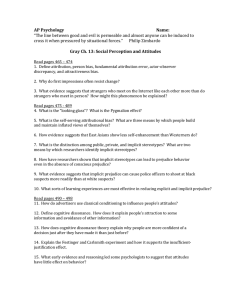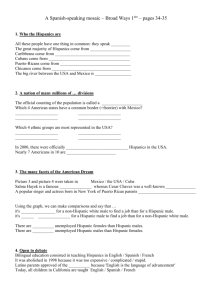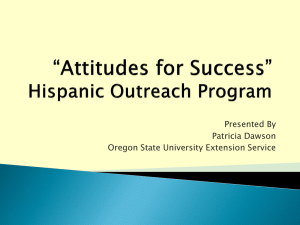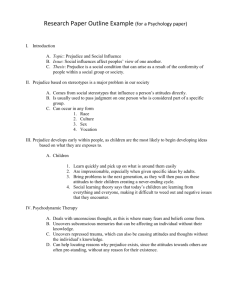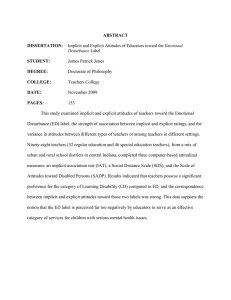Thesis Advisor Dr Heather L Adams
advertisement
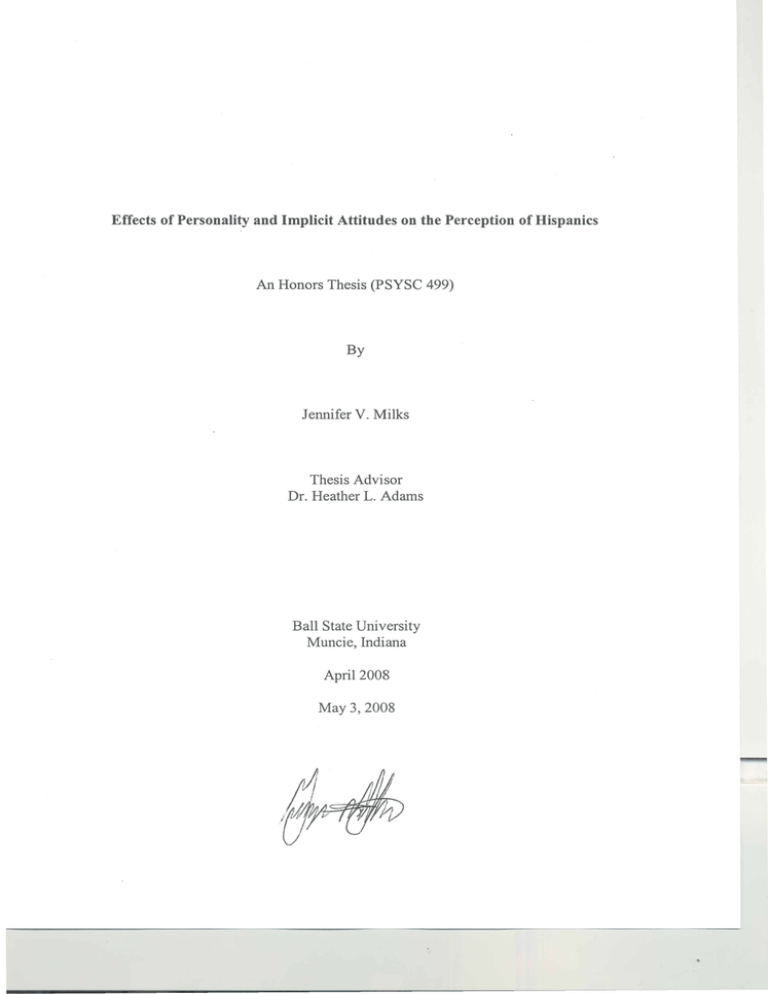
Thesis Advisor Dr. Heather L. Adams Ball State University Muncie, Indiana First and foremost, I would like to thank Dr. Heather Adams for her indispensable guidance, insight, encouragement, and mentoring. This entire thesis would not have been possible without the knowledge and advice she shared with me. Also, special thanks must be extended to Dr. David Perkins, Tracey Randolph, Jacquelin Clark and Jarren Mattingly for their continual support and advice throughout the past year. To Dr. Johnathan Forbey and Dr. John Wallace, I greatly appreciate the direction you provided during the development of my study, particularly concerning the formation ofthe personality survey component. In addition, I would like to thank Dr. Michael Tagler for his support and advice concerning the use and statistical analysis of the Implicit Association Test. Your insight helped me to clarify some of the questions and uncertainties I had concerning the IAT and its correlation to personality. Kelly Harlow, Amanda Pollard, Kristen Ruhl, and Susan Rosenthal deserve a great deal of my gratitude for assisting me with reserving a room for data collection. Finally, I would particul~rly like to thank Dr. James Weyant of the University of San Diego for so graciously sharing with me his version ofthe Implicit Association Test. Without the IA T and Dr. Weyant's generosity, this thesis would be drastically different. Effects of Personality and Implicit Attitudes on the Perception of Hispanics Jen Milks Ball State University Abstract This two-part study is an exploration of the sources of prejudiced attitudes towards Hispanics as a means of understanding the personal and societal factors that influence negative perceptions of this growing sector of the population. The first component of the study examines whether a Five Factor ("Big Five") personality trait, Openness to New Experience, is a predictor of prejudiced attitudes. Follow-up interviews were conducted in order to identify various sources, personal and societal, that may contribute to racially prejudiced attitudes and stereotypes of Hispanics. Ultimately, the findings of this study suggest that Openness is not a predictor of implicit prejudice. Furthermore, the interviews revealed four common themes that address several possible explanations for the continued existence of negative stereotypes of Hispanics. Introduction The unequal treatment of racial minority groups has been and remains a pervasive problem in the United States. Research indicates that individuals who are identified as members of a minority group, subsequently, are perceived as inferior and deficient (Salina & Lesondak, 2002). Furthermore, from the perceiver's perspective, an individual's minority group membership provides sufficient justification for denying specific civil rights and equal access to resources (Salina & Lesondak, 2002). More recently, Hispanics have become a prime target for racial prejudice, particularly because of the rapidly increasing national concern about immigration (Pew Hispanic Center, 2006). Weaver (2005) attests that knowledge about the stereotypes of ethnic groups is important because it is key in the generation of prejudiced attitudes. Flynn's (2005) study suggests that stereotypes affect the interracial impression formation of African Americans due to negative stereotypes ascribed by Whites. Her findings may explain why certain minority groups are being denied equal access to resources in comparison to other sectors of the population. Less research has been reported concerning Hispanics, although Weyant (2005) verified that participants hold, at least on an implicit level, a negative stereotype that Hispanics are less intelligent than nonHispanic Whites. Yet, there is no evidence to suggest that individuals with Hispanic origins are inherently less intelligent than any other racial or ethnic group. Nonetheless, the negative stereotypical portrayal of Hispanics may foster damaging perceptions of Hispanics both for ingroup members as well as out groups (Rivadeneyra, Ward & Gordon, 2007). Furthermore, this negative stereotype may explain why Hispanics are less likely to obtain a high school diploma or college degree in comparison to the total population (U.S. Census Bureau, 2004). Hispanics receive the lowest average financial aid of any racial or ethnic group, which an important determinant of whether an individual participates in and completes higher education (How Latino students pay for college, 2005). Therefore, it is no surprise that Hispanic participation in higher education is lower than other group. Additionally, their lower educational attainment may explain why the median family income for Hispanics is lower than the median family income for all families by $15,000 (U.S. Census Bureau, 2004). With an understanding of the influence that stereotypes have on our perceptions of minorities, it is important to consider whether there is a component of personality that makes some individuals more likely to hold negative prejudiced attitudes. Gordon Allport's study on generalized attitudes provides one possible explanation for the unequal access to resources Hispanics endure. In conjunction with Adorno, Frenkel-Brunswick, Levinson, and Sanford's research on The Authoritarian Personality, Allport illustrates that individuals who reject one out group are likely to reject another (Duckitt, 2005; PIous, 2003). As such, Allport contests that a generalized prejudiced attitude is essentially a component of one's personality (Duckett, 2005). More recent research has explored this connection of personality and prejudice. Flynn (2005) reported that racial prejudice can be predicted using the Five Factor personality trait test ("Big Five"). Although results have been inconsistent, the Openness to New Experience domain has been reported as the strongest, most consistent predictor of racial prejudice when assessed using explicit measures of prejudiced attitudes (Flynn, 2005). To explicate, individuals with high Openness scores are likely to be accepting of the unfamiliar and, subsequently, are believed to possess less racist attitudes. Furthermore, an individual with a high Openness score is more willing to consider stereotype-discontirming information about Black individuals, and therefore, more likely to adjust her impressions accordingly (Flynn, 2005). On the other hand, an individual who scores low on Openness is likely to be less accepting of nuances and, therefore, is predicted to hold racist attitudes. Flynn (2005) confirms the relationship between racial prejudice toward African-Americans and the Openness scale. However, there is no research connecting prejudice attitudes and Openness to the Hispanic population. Therefore, one aim of this study is to compare Openness to Experience scores to racially prejudice attitudes, specifically targeting the attitudes towards members ofthe Hispanic population using measures of implicit associations. Flynn's (2005) study relied on explicit measurements of racial attitudes, which she admitted may be flawed because of an individual's unwillingness to convey such attitudes openly. Therefore, the current study uses a Hispanic version of an implicit association test (IAT), designed by Dr. James Weyant, in hopes of bypassing the effects that social desirability may have on self-reported measures of racially prejudice attitudes. The IA T uses an individual's latency response rate as a means of calculating implicit associations between frequently used Hispanic names and adjectives describing unintelligent traits. Slower response times with greater errors indicate that an individual holds strong implicit associations that Hispanics are unintelligent (Lane, Banaji, Nosek & Greenwald, 2007). Another goal of this study is to uncover various perceptions of Hispanics in the U.S. and the sources through which these perceptions or stereotypes are being perpetuated. Two common myths about immigrants in the U.S. are: (1) they exhaust the society's resources, and (2) they refuse to assimilate (Cole, 2003). In regards to the first myth, Cole (2003) evidences that the total revenue gained from the taxes paid by immigrants is higher than the cost of services they receive. Therefore, immigrants are an overall benefit to the economy. Bills (1997) contests the second myth by demonstrating that Hispanics are assimilating as evidenced by the extensive and continual language shift to English that is occurring among the Spanish-speaking population. These myths may target and affect all Hispanics because of people's inability to distinguish a Hispanic immigrant from a Hispanic U.S. citizen; therefore, resulting in negative attitudes towards the whole group. One window for understanding the source of these stereotype perceptions is through media portrayal of Hispanics. Presently, media portrayals have a pervasive affect on the perceptions of various groups within our society (Harwood & Anderson, 2002). When we lack interaction with a particular group of people, media representations serve as the predominant information-provider. Mendez-Mendez and Alverio (2001) reveal that stories about Latinos that air on prime-time news channels "continue to be seriously underrepresented in television news and their portrayals are often stereotypical and highly divergent from the true essence of Latino society and culture" (p. 3). Most of these news stories focus on Latinos as immigrants or their use of Spanish, neglecting to address their citizenship status or "the fact that most U.S.-born Latinos are either bilingual or do not speak Spanish" (p. 3). Cole (2003) cites misinformation as one potential substitute for logical reasoning and fairness. Nonetheless, Weaver (2005) argues that the image of Hispanic Americans is not inflexible, but has changed between 1990 and 2000. Therefore, there is potential for a shift to an overall positive perception of Hispanics if the sources of negative perceptions are better understood. Furthermore, it is important to be aware of and track these changes in interracial perceptions as it may reflect an increase or decrease in unequal access to resources based on prejudiced attitudes toward a marginalized group. It is the dual goal of this study to assess the perceptions of individuals toward Hispanics while considering the possible misperceptions that our culture presents. Therefore, the two guiding research questions for this study are: 1. Is Openness a predictor of implicit prejudiced attitudes regarding Hispanics? 2. What sources of information confirm and/or challenge stereotypes of Hispanics? Method Study 1: Quantitative Thirty-six undergraduate students (18 females, 17 males, 1 no response) from the Department of Psychological Science General Psychology 100 student pool at Ball State University volunteered for the first part of a two part study. On the research questionnaire, 35 students identified themselves as between the age range of 18 to 24 and one participant between the ages of30 to 39. The ethnic breakdown of the sample was as follows: 1 African American, 1 AsianlPacific Islander, 31 Caucasian (non Hispanic), 1 Latino/Hispanic, and 2 Other. The participants received one hour of research participation credit. Participants were assessed using the Hispanic version of the IA T (Weyant, 2005), a demographic questionnaire, and a "Big Five" Personality Trait test (Goldberg, 1999). Since the Hispanic Implicit Association Test requires specific software, all participants used the same computer, which was made available for them at the specified location. Individually, each participant was asked to meet the principal researcher in a private, enclosed room in the university's library. Before participation, each student was asked to read and sign an informed consent and an additional form, indicating whether he/she would be willing to participate in a follow-up interview for $30 at a later point in the semester. If the participant agreed to be considered for a follow-up interview, he/she provided the researcher with contact information. All participants' survey data was used even if they selected not to participate in the follow-up interview. Participants were instructed that they would be completing three different tests in the following order: IAT, general questionnaire, and personality test. The principal researcher was not present in the room while the participant completed each task; however, she was available outside ifthere were any complications. Additionally, the principal researcher assisted with the transition between tasks. Study 2: Qualitative Interviews From the sample of participants in Study 1, six individuals were selected for interviews based on their scores on the Hispanic lAT. All of these selected participants were Caucasian. The goal was to obtain two groups of three individuals each that would represent the most extreme scores. Consequently, this would create a dichotomy between interviewees: those who highly associated Hispanics with unintelligent, and others who demonstrated no negative bias. Each individual was interviewed separately and paid $30 for participating in the interview. Prior to participation, the interviewees were provided with an informed consent explaining the purpose of the second component of this study. The researcher addressed any questions or concerns of the participant before beginning the interview. Each participant was also asked to select a pseudonym in order to maintain the confidentiality of the interview data. All the interviews were conducted by the principle researcher in a private, enclosed room in the university's library. The interviews were semi-structured and contained questions about the interviewee's sources of information, experiences meeting new and different people, personal exposure to and interactions with Hispanics, and their beliefs about the general perceptions of Hispanics as well as personal perceptions. Each interview was audio-recorded using a standard tape-recorder and expected to last approximately half an hour. Study 1.' Quantitative Analysis To examine the first research question, the relationship between IAT score (M= -.029, SD = .751) and Openness score (M=72.29, SD = 11.64) was assessed using a Pearson correlation. For an alpha level of .05, the correlation between IAT and Openness was not significantly significant, r (33) = .007,p > .05. This indicates that the IAT response latency is not related to an individual's Openness score. Correlations between IAT and the four additional NEO Domains were also assessed for an alpha level of .05. None ofthe domains yielded statistically significant results as well: Neuroticism (M=53.20, SD = 17.45), r (33) = -.156, p > .05; Extraversion (M=73.71, SD = 13.56), r (33) = .004, p > .05; Agreeableness (M =75.40, SD = 9.00), r (33) = -.045, p > .05; Conscientiousness (M =71.14, SD = 14.72), r (33) = .090, p > .05. Study 2: Qualitative Analysis Thirty-two participants from Study 1 opted to be considered for a follow-up interview. From this group, one individual was omitted from the interview selection pool because more than 10 percent of this participant's latency responses were less than 300 milliseconds. A frequency distribution was run in order to select six participants who represent the most extreme scores using the IAT D variable (Figurel). This distribution shows that in total 13 participants received positive D scores and 22 participants received negative D scores. Overall, this indicates that more participants held no negative bias towards Hispanics as less intelligent than Whites. Five of the six individuals who were contacted participated in follow up interviews. Three interviewees reported positive D scores that indicate a negative bias against Hispanics (Matt, +2.80; Rachel, + 1.20; Sally, +0.91). Two interviewees reported negative D scores, People especially in my family it was kind of the way they grew up I guess. Like their parents taught them that this was bad, and especially in my family - race. People who are not white like are bad. Like that's how they were raised I guess. And, so, my mom thinks that. And I mean I think part ofthem like wants to get to know other people, but I think it's just, for some reason, in their minds it's wrong. (Rachel) Obviously if you're raised in family like you can, I mean, you can change your beliefs and your ways but it's kind of hard. You know, like, urn my family is kind of racist towards them and ... So when I'm with them I kind of.. .think that way because that's how I've been taught to think. (Sally) It was just like, you know, skin color doesn't have anything to do with anything. And that's, like that's how I was brought up. There is no such thing as a skin color. Everybody's seen the same way. (Beth) I don't know I just wasn't raised that way. I was always raised, you know, can you do the work or not? (Drew) There's stereotypes that people develop from, you know, young ages. And you know you break that when, you know, you actually interact with the people of whatever stereotype you have. (Drew) It was probably, I would say life changing may be a little too, like, oh man, like huge. But I don't know how else to describe it because I can't judge a book by its cover now because ofthat experience, because you never know, you know, if this person that you portray to be as bad through stereotypes is actually a really good person. (Beth) But I mean after a while it was just like oh he's just playin around and I got use to it [being whistled at]. But I mean it was kind of, it was negative for a while because I didn't know how to handle it because it was something I'd never gone through before. (Beth) Because I'm pretty good at telling like what kind of person they are just by the first conversation. (Rachel) I just got that impression right when I met him. I had a feeling it was gonna be like that. (Matt) I'm trying to think of another movie to give you ... I can't really I guess. But. . .in a lot of other movies I know they are, like I said, they were like in prison or something, or urn with like the big families, or something like that. They're just kind of looked down upon in movies so that's just kinda how you think. (Sally) I don't know if I've read anything, but just seeing things on TV and in the movies and just every kind of media ... I know I've seen a movie where Hispanics are just kind of ... Oh, Stand and Deliver. There we go. (Beth) There's a movie about the stereotypes of Blacks - American History X ... You're just like, well there it goes. Everyone can go to prison based on what you do. (Drew) I just watched a movie the other day called Crash... Like usually in others ... they're in prison or something in some movie or things like that. (Sally) You can get on You Tube and there's a lot of videos - I'm sure videos making fun of everybody- but there's a lot of videos that make fun of Hispanics and that kind of thing and make fun of their work ethic. (Matt) I guess there's an equal amount of all races on there. But, I guess some people pay more attention to this one or the other. You know, people always say the prisons are like 90% Black people, or stufflike that. And then you just start playing into it. (Drew) study suggest that this particular personality trait does not predict nor exclusively explain an individual's implicit racial biases. However, this does not necessarily mean that Openness does not partially contribute to racially prejudiced attitudes. One possible explanation for these unexpected findings is the change from using explicit measures of prejudice attitudes to an implicit measure, the lAT. Previous findings that indicate a connection between Openness and self-reported prejudice attitudes suggest that Openness may only correlate with explicit measures of prejudice. This study's contradictory results may be attributed to our use of an implicit association test. The IA T uses latency response times to test an individual's implicit associations, which examines a cognitive component of prejudiced attitudes. As such, a mismatch may exist between this implicit measure of prejudice when correlated to a self-reported, explicit measure of personality. The second research question aimed to understand and identify the sources of White's prejudiced attitudes towards Hispanics, in hopes of improving interracial attitudes and obstructing the continuous unequal treatment of racial minority groups. Five interviews were conducted to uncover the possible sources of prejudice from the perspective of White, collegeage students. Interracial attitudes of parents, personal exposure to and interactions with Hispanics, and various forms of media were distinguished as the primary influences of interracial impression formation. To examine these sources and further implications, each of the four emerging themes will be expounded upon separately. The first source of information was verified by four out of the five participants explicitly. The findings suggest that children assume the interracial prejudice attitudes oftheir parents (Theme I). Two of the three interviewees (Rachel and Sally), whose IAT scores indicate that they hold negative biases toward Hispanics, claim that their parents hold racist attitudes. On the other hand, Beth and Drew, whose IAT scores indicate no negative biases towards Hispanics, claim that their parents were racially tolerant. Therefore, it seems that individuals adopt those values they learn from their home environment. Furthermore, the difference between these groups reveals that the IA T may in fact be an accurate assessment of an individual's ingrained racially bias cognitive associations. By assessing the differences between the two groups, who scored on opposite extremes of the lAT, this study suggests that mere exposure to racial diversity does not decrease prejudice attitudes or reliance on negative stereotypes. Instead the findings from Theme 2 indicate that extended and direct interaction with members of the Hispanic population constitute meaningful interracial exposure experiences. Beth and Drew, who had long-term and direct experiences with Hispanics, believed in the power of personal interactions to change their preconceived notions of racially diverse groups. However, it is important to consider the intersection between upbringing and these personal experiences. Since both these individuals had racially tolerant parents and meaningful interactions with Hispanics, we cannot be certain which variable impacted their racial attitudes, or whether both had an equal role. Furthermore, two ofthe three interviewees with positive D scores demonstrated confidence that their initial impressions of people were accurate. However, they also believed it was important to get to know someone before passing judgments. This inherent contradiction helps to explain their implicit prejudiced attitudes when compared to the other group of interviewees. If Rachel and Matt believe they can know a person through a short interaction, it is likely they are still relying on stereotypes in order to catalog certain individuals quickly, regardless of their previous claim about withholding immediate character assessments. Theme 3 addresses the difference between. the members of the two IA T groups' ability to recall stereotype-confirming sources of information. Those individuals who hold negative biases could not identify sources of information that challenged the negative perceptions of Hispanics. This suggests that these negative stereotypes fit with their personal perceptions of Hispanics, and therefore, incidences that represent Hispanics in a stereotypical light do not seem out ofthe ordinary or noteworthy. Alternatively, for the interviewees who demonstrated no implicit bias against Hispanics, they were capable of providing specific stereotype-confirming examples possibly because they do not believe that the stereotypical portrayal of Hispanics is an accurate representation. Additionally, they were more likely to explicate that stereotypes were merely generalizations that do not epitomize every member of the group. Regardless of one's D score, most ofthe interviewees recognized movies as the most powerful and influential source of stereotype-disconfirming information, specifically movies with minority group members cast in lead roles. Therefore, if we are attempting to change the pervasiveness and impact of negative racial stereotypes more research should be done to confirm these findings so we may more successfully invest time, energy, and resources in the appropriate and effective mediums. Finally, Theme 4 suggests that participants believe that various forms of media portray negative racial stereotypes of all races. The further implication of this assertion suggests that this equalizes the impact of negative racial stereotypes for all races. However, it is important to consider that even if all races were depicted negatively with equal frequency, some individuals pay more attention and catalog the negative stereotypes of some racial groups more than others. Strengths and Limitations Additionally, if people can change their self-reported prejudice beliefs, are they also capable of disregarding or changing their own implicit associations? Since the values parents hold seem to be adopted by their children, are individuals capable of changing the beliefs they assume at a young age? To address this concern, future research should also explore the extent to which implicit associations control and guide behavior. In conclusion, we understand from this study that knowledge about personality traits may not be the best means of combating negative racial stereotypes. Instead, we learned that films that address and challenge these stereotypes are most effective regardless of an individual's implicit biases. Therefore, similar to Flynn's (2005) goal, I endeavor to use the current study as a way to increase the knowledge about implicit biases and interracial impression formation in order to assist researchers and the media in developing interventions aimed at reducing the impact of negative racial stereotypes in media. Allport, G. W. (2003). Prejudice as a generalized attitude. In S. PIous (ed.), Understanding Prejudice and Discrimination (pp. 444-445). New York: McGraw Hill. Bills, G. D. (1997). New Mexican Spanish: Demise of the earliest European variety in the united states. American Speech 72(2), 154-171. Retrieved from CSA Linguistics and Language Behavior Abstracts database. Cole, D. (2003). Five myths about immigration: The new know-nothingism. In S. PIous (ed.), Understanding Prejudice and Discrimination. (pp. 167-169). New York: McGraw Hill. Duckitt, J. (2005). Personality and Prejudice. In Dovidio, F., Glick, P., & Budman, L. (ed.), On the Nature of Prejudice: Fifty years after Allport. (pp. 395-412) Malden: Blackwell Publishing Ltd. Flynn, F. (2005). Having an open mind: The impact of openness to experience on interracial attitudes and impression formation. Journal of Personality and Social Psychology, 88(5), 816-826. Harwood, J. & Anderson, K. (2002). The presence and portrayal of social groups on prime-time television. Communication Reports, 15(2), 81-97. How Latino students pay for college: Patterns of Financial Aid in 2003-2004 (August 2005). Excelencia in Education and Institute for Higher Education Policy. http://www .edexcelencia. org/pdf/LSA eng.pdf Lane, K. A., Banaji. M. R., Nosek, B. A. &Greenwald, A. G. (2007). Understanding and Using the Implicit Associaiton Test: IV: What We Know (So Far) about the Method. Implicit Measures of Attitude, 59-102. Mendez-Mendez, S. and A1verio, D. (2001). The Portrayal of Latinos in Network Television News, 2000. Report prepared for the National Association of Hispanic Journalists. Pew Hispanic Center (2006). The State of American Public Opinion on Immigration in Spring 2006: A Review of Major Surveys. Washington, D.C.: Pew Hispanic Center. Rivadeneyra, R., Ward, L. M. & Gordon, M. (2007). Distorted Reflections: Media Exposure and Latino Adolescents' Conceptions of Self. Media Psychology 9,261-290. Salina, D. D. & Lesondak, L. M .. (2002). Preventing racist, sexist, and heterosexist behavior. In Innovative Strategies for Promoting Health and Mental Health Across the Life Span (pp. 301-323). New York: Springer Publishing Company. U.S. Census Bureau (2004). We the people: Hispanics in the united states (December 2004). Washington, DC: U.S. Printing Office. Weaver, C. N. (2005). The changing image of Hispanic Americans. Hispanic Journal of Behavioral Sciences 27(3), 337-354. Weyant, J. (2005). Implicit stereotyping of Hispanics: Development and validity of a Hispanic version of the implicit association test. Hispanic Journal of Behavior Sciences 27(3), 10 Frequeucy Mean =-0.03 Std. Dev. =0.751 N=35
